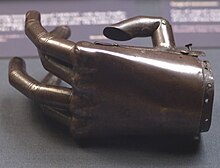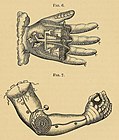Iron hand (prosthesis)
Passive metal hand and arm prostheses from the late Middle Ages and early modern times are referred to as iron hands (sometimes also knight's hands ) . These artificial hands combined cosmetic (" jewelry hand ") with functional properties. Its most famous representative is the younger of the two Iron Hands of the knight Götz von Berlichingen , created around 1530 .
A list of such hand prostheses known today can be found in the list of iron hands .
background
Purely cosmetic artificial hands made of various materials such as wood and leather are known from the earliest times. Functional working hands with a kind of hook may also have been widespread quite early on. The “Iron Hand” of the pirate Arudsch probably belongs to this group . Karl Sudhoff speculated that the iron prosthesis of the Roman officer Marcus Sergius Silus could have been an early form of passive art.
Mechanical hand and arm prostheses with movable fingers, however, have not been proven before the late Middle Ages. The oldest known of these hands, the so-called First Hand from Florence , dates back to the 15th century. The earliest documentary mention is an invoice from 1476 for an artificial hand, which the art blacksmith and watchmaker Ulrich Wagner, originally from Munich , had made for the gunsmith Ulrich Wyss on behalf of the council of the Swiss city of Freiburg . It is probably the handicraft exhibited today in the Musée d'art et d'histoire de Friborg .
From the time between the artificial limbs of antiquity and these iron hands there is no evidence of prostheses for the upper extremity. The spread of constructions in the style of the older Götzhand suggests that as early as the end of the 15th century there was "a European development or at least an eager exchange of knowledge and technology transfer within the entire continent" ( Liebhard Löffler ). The Iron Hands were particularly widespread during the Peasant Wars ( 1524-25), the Thirty Years War (1618-48) and the French Revolution (1789-92).
The French surgeon Ambroise Paré , who also introduced amputation with arterial ligation instead of cauterization , showed in his oeuvres at the end of the 16th century - in addition to leg prostheses that were very advanced for his time - also mechanical artificial hands that he obtained from one of the few prosthesis makers known by name, the Little Lorraine , had it made.
The relatively long period up to the 18th century, during which such art hands were produced without major changes, makes it difficult to categorize individual specimens precisely. For example, a hand that is in the Germanic National Museum in Nuremberg is dated by the latter to the 18th century, although it is probably much older.
construction

Most of the art hands are made of sheet iron or brass and are therefore relatively heavy (the younger Götzhand weighs around 1.5 kg). All hands are passive, so they cannot be moved arbitrarily . The fingers are bent in with the help of the healthy hand or by propping up; the hand is opened again by spring force . In most designs, the fingers can only be brought into the starting position ( extension position ) together, but there are also hands with their own actuation buttons for the thumb or the individual finger blocks.
The joints are locked using a more or less complex locking mechanism with pawls and leaf springs . Due to the mechanism, which is similar to a battery lock, the operation of such an artificial hand is quite loud. There are iron hands with and without flexible thumbs . With most artificial hands, it is not opposable when it is flexible because it runs past the index finger . A tweezer grip is not possible with it.
In most cases, the mechanism is housed inside the palm of the hand, the constructions only differ in the details of the execution. One of the few exceptions is the Ingolstadt hand , where the mechanism is on the outside of the hand. In the younger Götzhand, the wrist can also be bent and the hand rotated in relation to the arm cuff ( pronation or supination ). Arm prostheses also have an artificial elbow joint .
These artificial hands were probably attached to the upper arm or shoulder with leather loops . Such leather straps and also possible upholstery are mostly not preserved. In addition, iron hands usually have a long, iron forearm cuff , which was also used for attachment. The bracers were often "windowed" to save weight.
The fingers are often artfully modeled and the heels of the hands shaped. Many hands also show traces of a previously existing flesh-colored paint.
Designs
The Iron Hands can be divided into several larger groups according to their construction. In the first, the index, middle, ring and little fingers are combined into a common block that can be moved in the base joint . This is the oldest and simplest design from the late Middle Ages , which also includes the oldest known iron hands, the oldest Florentine hand from the second half of the 15th century.
Iron hands with two independently movable finger blocks appeared from the beginning of the 16th century. This group includes many preserved hands from the Renaissance period , such as the older Götzhand, the Darmstadt hand and the Altruppiner hand .
The oldest known artificial hands with four independently movable limbs include the second hand from Florence and the Ingolstadt hand in the Bavarian Army Museum , a left child's hand with a firm thumb and a mechanism on the outside. Another prosthesis with individually movable fingers from the 16th century is now in Cleveland ( USA ). As a rule, the fingers are only movable in the base joint here.
The highlight of the development is undoubtedly the Balbronn hand and the younger Götzhand . Here the fingers can be articulated in two or three joints . Compared to earlier versions, this leads to a much more complex mechanics, but nothing changes in the basic functional principle. These prostheses are also still passive, i.e. the fingers must be brought into the desired position with the healthy hand or by propping up. The special importance of the Balbronn hand lies in the fact that it can be classified relatively precisely in terms of time because of its find situation: It was definitely made before 1564. As it is very likely that it comes from the same manufacturer as the younger Götzhand, its authenticity and date are also evident secured.
First hand from Florence (oldest known Iron Hand), second half of the 15th century
Designed by Ambroise Paré , late 16th century
Handicraft from the Henry Wellcome Collection , 17th century
Use and effect
The spread of the famous Iron Hands shows a concentration on Central Europe . However, prostheses are also known from Great Britain and Scandinavia , the latter perhaps arriving there during the Thirty Years War.
Since iron hands are passive, they are only suitable for holding objects with the help of the healthy hand. Practical tests have shown that with such a passive prosthesis one could grip various objects such as reins or, under certain circumstances, a shield . However, contrary to rumors to the contrary, they were not suitable for wielding a sword or a lance . In addition, the fingers could not be adjusted continuously. The practical use was further restricted by the detent (three-stage with the older Götzhand).
Because of the complex and expensive production, such art hands were always reserved for a small group of wealthy people. Most of the porters were probably nobles. Among the surviving Iron Hands are several that, due to their size, were probably intended for children, including the Second Nuremberg Hand from the 16th century .
In historicism and under the influence of Goethe's drama , a great number of artistic hands were ascribed to the historical Götz von Berlichingen , including left hands and prosthetic arms with artificial elbows. The two prostheses that can actually be assigned to Götz are now in the museum of Götzenburg Jagsthausen .
The younger Götzhand inspired the designers Peter Ballif and Caroline Eichler in the 19th century to develop the first modern hand prostheses. Ferdinand Sauerbruch later also took it as a model when developing his “ Sauerbruch arm ”.
literature
- Liebhard Löffler: News from old hands: Newly discovered and previously neglected arm and hand prostheses. In: Orthopedic technology. No. 5, 1981, pp. 75-81.
- Liebhard Löffler: The substitute for the upper extremity: the development from the first evidence to the present day. Enke, Stuttgart 1984, ISBN 3-432-94591-4 .
- Raoul Blanchard: Ulrich Wagner: Eiserne Kunsthand (1476). Pages of the MKGF, 2000-2, Freiburg i. Üe. 2000.
- Vittorio Putti : Historical Prostheses. In: Journal of Hand Surgery. Vol. 30, No. 3, Edinburgh 2005, ISSN 0266-7681 , pp. 310-325.
Web links
Individual evidence
- ↑ a b c Wiebke Ada de Boer: Clinical picture of acquired amputations in childhood - retrospective analysis of 124 patients from the clinic and polyclinic for technical orthopedics and rehabilitation in Münster from 1986 to 2003. Münster 2008, p. 2f. ( Digitized version ).
- ↑ Günter Quasigroch: The hand prostheses of the Frankish imperial knight Götz von Berlichingen. 2nd continuation: the second hand. In: weapons and costume studies. Vol. 25, 1983, pp. 103-120.
- ^ Liebhard Löffler: News from old hands.
- ^ Raoul Blanchard: Ulrich Wagner: Eiserne Kunsthand (1476).
- ^ Marianne Rolle: Ulrich Wagner. In: Historical Lexicon of Switzerland . July 2, 2012 , accessed June 26, 2019 .
- ↑ a b c d e f g Liebhard Löffler: The substitute for the upper extremity.
- ↑ a b Simone Kahlow: Prostheses in the Middle Ages - an overview from an archaeological point of view. In: Cordula Nolte (ed.): Homo Debilis. Disabled - sick - disabled in medieval society. Studies and texts on the intellectual and social history of the Middle Ages, Volume 3, Didymos-Verlag, Korb 2009, ISBN 978-3-939020-23-3 , pp. 203-223.
- ↑ Günter Quasigroch: The hand prostheses of the Frankish imperial knight Götz von Berlichingen. 1. Continuation: The first hand. In: weapons and costume studies. Vol. 24, 1982, pp. 17-33.
- ↑ a b Martin Friedrich Karpa: The history of the arm prosthesis with special consideration of the performance of Ferdinand Sauerbruch (1875–1951). Bochum 2004, p. 18 ff. ( Digitized ; PDF; 4.5 MB).









